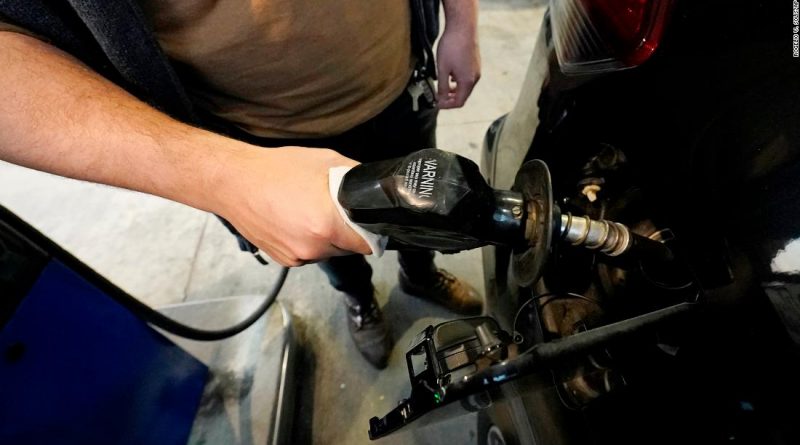'Robbing Peter to pay Paul': Romans explains what a gas tax holiday is
New York (CNN Business)In the last few months, Yumekia Jones, a legal assistant at the Mississippi Center for Justice’s Indianola office, has fielded an unusually high number of calls — a roughly 400% spike — from people in dire need of immediate financial assistance.
Most want to avoid payday loans, which offer quick cash against future paychecks without a credit check and come with an interest rate above 500%. But the rapidly increasing prices of food, fuel and rent gives them few options.
Inflation rates are at a 40-year high and unemployment is near a half-century low. To most economists those two realities spell out significant economic trouble.
To predatory payday lenders, however, they signal happy days and good times ahead.
“Low unemployment plus inflation generally mean consumers may need loans for additional capital to manage through unexpected spikes and expenses while earning money to pay back these loans,” said David Fisher, CEO of short-term, subprime lender Enova (ENVA) said during an earnings call in May. The company beat quarterly earnings estimates by 7.7%.
Given the economic dynamics at play, Fisher said his company has “meaningfully leaned into the demand with our marketing efforts,” and spent more to attract new customers. That has paid off. About 44% of all loans were issued to new customers in the last quarter, he said.
That increase in first-time borrowers came as US consumer inflation reached its highest level in more than four decades and Americans struggled to put food on their tables and gas in their tanks.
Working to drive to work
The national average for a gallon of gas stands at just under $5, a 61% increase since last year. The jump comes just as many employers are requiring workers to return to in-person work. The federal minimum wage, meanwhile, still stands at $7.25 per hour, where it’s been since 2009. Low-wage workers must labor for about 14 hours to fill up their tank.
About two thirds of Americans now live paycheck to paycheck, a June LendingClub survey found. That number jumps to 82% among workers earning less than $50,000.
The average credit score for low-earners in the US is also dropping, according to LendingClub data. About 40% of Americans earning less than $50,000 and living paycheck to paycheck have a subprime credit score of below 650 making it difficult for them to get a loan through a traditional lending institution or to qualify for additional credit. The average credit score in the US is 714, according to Experian.
For those Americans, high-interest payday loans are still easily accessible. These small-dollar amount loans, typically between $100 and $1,000, are available in more than half of all US states with little regulation. Proof of income and a bank account is all most borrowers need to walk out with cash in hand.
Current data that tracks the number of payday loans has yet to be released, but based on past trends there is likely an increase in borrowing, said Alex Horowitz, principal officer for Pew’s consumer finance project. “Our survey data shows that about 70% of payday loan borrowers use the loan primarily for routine expenses and to cope with increased or volatile expenses.”
The debt trap
These loans are often incredibly expensive but borrowers either lack the financial literacy to seek out alternatives or don’t think they have any other option. There is currently no federal cap on maximum interest rates for small-dollar loans. Not all states allow them, and it is up to that states that do to decide whether they’ll implement their own caps.
In the 32 US states that allow payday lending, average annual interest rates range from 200% in Minnesota to 664% in Texas.
Borrowers often can’t pay the full amount of the loan back when it comes due, typically in two to four weeks, leading them to take out a second loan with additional fees. That creates a cycle of debt that is hard to break. Nearly 1 in 4 payday loan recipients take additional loans nine times or more, the Consumer Financial Protection Bureau found.
Studies show that Black and Latino communities are disproportionately targeted by providers of high-cost loans. In Michigan, where the average payday loan interest rate is 370%, there are 7.6 payday stores for every 100,000 people in areas where the population is more than a quarter Black and Latino. That’s about 50% more than other areas, according to data provided by the Center for Responsible Lending.
Companies that offer high cost loans say they provide a needed service to low income communities by issuing loans to Americans that traditional banks refuse to serve. They claim the high interest rates are necessary because of the high risk of default. But consumer advocates say this is a false narrative.
Seven large US banks, including Bank of America, Wells Fargo and Truist, have created programs that offer small-dollar borrowing options with low annual interest rates, Horowitz said. They plan to look at banking history — not credit scores — to determine who qualifies for loans.
“There are 18 states and the District of Columbia that have banned payday loans and have survived just fine without these predatory lending products,” said Nadine Chabrier, senior policy counsel at the Center for Responsible Lending. “There are fair and responsible lending products that have low interest rates and fees that are available and that people can use.”
Shortly after the Covid-19 pandemic hit the US, the Consumer Financial Protection Bureau repealed major parts of a 2017 rule that required lenders to evaluate consumers’ ability to repay loans. The rule, they said, would have wiped out much of the money they make from borrowers who miss payments on their loans. By repealing portions of the rule, the CFPB said it would ensure “the continued availability of small-dollar lending products for consumers who demand them.”
In a blog post, Former CFPB director Dave Ueijo expressed concern with the rule changes, saying that he has problems with “any lenders’ business model that is dependent on consumers’ inability to repay their loans.”
Buy now pay later
Advocates also worry about new forms of lending that have emerged in recent years that are generally much less regulated than even payday lending.
Buy now, pay later (BNPL) companies saw their total market share grow between 200% and 350% during the past two years, according to the Center for Responsible Lending. Now companies including Klarna and Zip are partnering with Chevron and Texaco to allow Americans to fill their tanks now and pay in installments over six weeks.
BNPL customers tend to be millennial and Gen Z-aged and two-thirds of applicants are subprime borrowers, according to research by Marshall Lux, a research fellow at the Harvard Kennedy School.
These companies don’t brand themselves as lenders. BNPL is not credit but debit, with repayments taken automatically from customers’ bank accounts and no interest or fees.
In California, 91% of consumer loans made in 2020 were BNPL loans, and 24% of financially vulnerable BNPL recipients report challenges making payments.
BNPL lenders are not required by law to determine a borrower’s ability to repay loans. There are no regulations regarding the disclosure of fees for late payments, account reactivation or rejected payments.
“If people are using a credit product like this for their basic needs I’m concerned,” Chabrier said. She worries that because BNPL customers are able to open multiple loans at once, they could lose track or have difficulty paying them all back.
“Many people use buy now and pay later to stack their purchases through multiple vendors,” Chabrier said. “Because of the lack of underwriting and the consideration of whether or not they can pay for these items, it becomes really unaffordable for them.”
Klarna caps late fees at 25% of the purchase amount, a far cry from the 400% interest rates payday lenders charge, but Chabrier sees this as a less severe symptom of a larger problem.
“They’re continuing this process of extracting money from low-income people,” she said. “If people have less buying power with their wages it will just get worse.”
Back in Mississippi, which has the highest rate of poverty in the country, Jones has struggled to keep distressed callers out of the hands of loan sharks and into financial literacy programs sponsored by local banks. But it’s difficult to work against so many payday lenders with huge advertizing budgets, she said. The state has the highest concentration of payday lenders per capita in the nation, mostly in low-income areas or in communities of color.
Payday lenders are so prevalent in Mississippi, Jones said, that they outnumber McDonald’s restaurants by more than 5 to 1.
Source: Read Full Article


